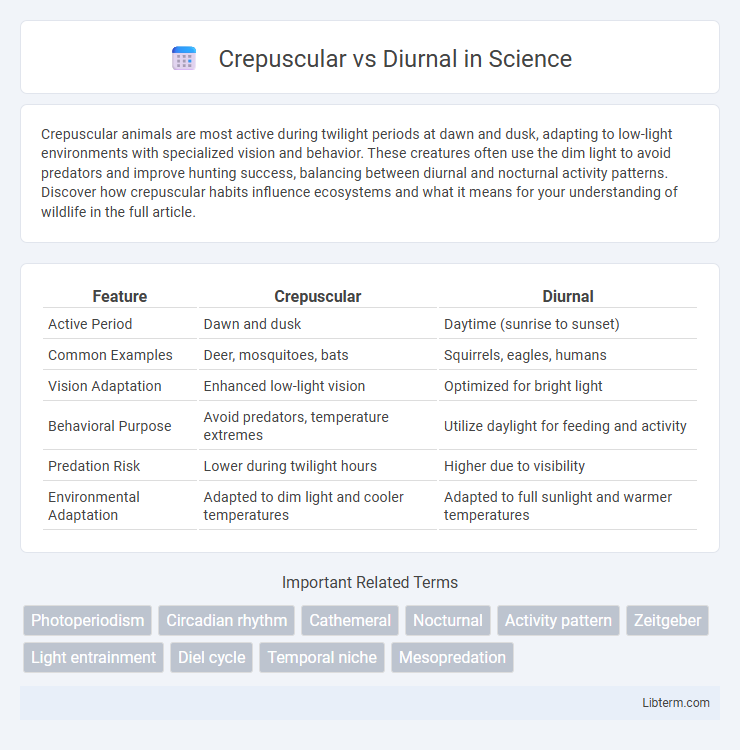Crepuscular animals are most active during twilight periods at dawn and dusk, adapting to low-light environments with specialized vision and behavior. These creatures often use the dim light to avoid predators and improve hunting success, balancing between diurnal and nocturnal activity patterns. Discover how crepuscular habits influence ecosystems and what it means for your understanding of wildlife in the full article.
Table of Comparison
| Feature | Crepuscular | Diurnal |
|---|---|---|
| Active Period | Dawn and dusk | Daytime (sunrise to sunset) |
| Common Examples | Deer, mosquitoes, bats | Squirrels, eagles, humans |
| Vision Adaptation | Enhanced low-light vision | Optimized for bright light |
| Behavioral Purpose | Avoid predators, temperature extremes | Utilize daylight for feeding and activity |
| Predation Risk | Lower during twilight hours | Higher due to visibility |
| Environmental Adaptation | Adapted to dim light and cooler temperatures | Adapted to full sunlight and warmer temperatures |
Understanding Crepuscular and Diurnal Behaviors
Crepuscular animals are primarily active during twilight periods of dawn and dusk, optimizing their behavior to avoid predators and extreme temperatures. Diurnal animals exhibit peak activity during daylight hours, benefiting from abundant light for foraging, social interaction, and navigation. Understanding these behavioral patterns reveals how species adapt to environmental cues and ecological pressures, influencing feeding, mating, and survival strategies.
Key Differences Between Crepuscular and Diurnal Animals
Crepuscular animals are primarily active during twilight periods at dawn and dusk, while diurnal animals are active during daylight hours. Crepuscular species often exhibit adaptations for low-light vision and cooler temperature activity, contrasting with diurnal animals, which have adaptations optimized for bright sunlight and higher daytime temperatures. These behavioral and physiological differences influence feeding patterns, predator avoidance, and habitat preferences between crepuscular and diurnal animals.
Evolutionary Advantages of Crepuscular Activity
Crepuscular activity, characterized by peak movement at dawn and dusk, offers evolutionary advantages such as reduced predation risk due to lower light levels and decreased competition for food resources. This temporal niche allows species to exploit cooler temperatures, conserving energy compared to the heat of midday experienced by diurnal organisms. Enhanced sensory adaptations for low-light conditions further optimize foraging and survival during twilight hours.
Why Some Species Thrive During Daylight
Species that thrive during daylight, classified as diurnal, benefit from enhanced visibility for foraging, communication, and predator avoidance. Daylight provides optimal conditions for photosynthesis, supporting herbivores and thereby sustaining food chains critical to diurnal species. The temperature regulation during daylight hours also facilitates metabolic efficiency and activity levels in these animals.
Environmental Influences on Animal Activity Patterns
Environmental factors such as light intensity, temperature, and predator presence critically shape crepuscular and diurnal activity patterns in animals. Crepuscular species are adapted to low light levels at dawn and dusk, minimizing thermal stress and predation risk, while diurnal animals maximize foraging time in well-lit conditions but face higher exposure to heat and predators. Seasonal changes and habitat characteristics further influence the temporal niche selection, driving evolutionary adaptations for optimal survival and resource utilization.
Notable Crepuscular Animals: Examples and Habitats
Notable crepuscular animals include white-tailed deer, which are commonly found in forest edges and meadows across North America, and the common vampire bat, native to Central and South American tropical and subtropical forests. Another key example is the red fox, which inhabits diverse environments such as urban areas, grasslands, and forests across the Northern Hemisphere. These animals have adapted to low-light conditions during dawn and dusk, optimizing their hunting and foraging activities to avoid predators and extreme temperatures typical of diurnal and nocturnal periods.
Prominent Diurnal Species in Nature
Prominent diurnal species, such as the African elephant (Loxodonta africana) and the honeybee (Apis mellifera), exhibit peak activity during daylight hours, relying heavily on visual cues for foraging and social interactions. Birds like the bald eagle (Haliaeetus leucocephalus) and the monarch butterfly (Danaus plexippus) also demonstrate diurnal behavior, optimizing their feeding and migratory patterns according to sunlight availability. These species adapt morphologically and behaviorally to exploit daylight environments, differentiating them clearly from crepuscular counterparts active during dawn and dusk periods.
The Impact of Light and Temperature on Behavior
Crepuscular animals are primarily active during dawn and dusk when light levels are low, adapting their behavior to avoid the intense daytime heat and predators. Diurnal animals exhibit peak activity during daylight hours, relying on higher light intensity for foraging and social interactions, with physiological adaptations to regulate body temperature in warmer conditions. Light intensity and ambient temperature significantly influence the circadian rhythms and behavioral patterns of both crepuscular and diurnal species, driving evolutionary adaptations that optimize survival and energy efficiency.
Adaptations for Survival: Crepuscular vs. Diurnal
Crepuscular animals exhibit unique adaptations such as enhanced low-light vision and heightened auditory senses to thrive during dawn and dusk, reducing predation risk and competition. Diurnal species possess advanced color vision and thermoregulation abilities, enabling efficient foraging and activity during daylight when visual cues and temperature fluctuations are prominent. These specialized adaptations optimize survival by aligning behavior with environmental light cycles and resource availability.
Human Interaction and Conservation Considerations
Crepuscular animals, active during dawn and dusk, often have limited human interaction compared to diurnal species that are active during daylight hours and frequently encounter humans in urban and recreational areas. Conservation efforts for crepuscular species must address habitat protection during low-light periods and minimize disruptions from artificial lighting, which can alter natural behaviors and increase predation risks. Diurnal species benefit from conservation strategies that manage human activities like tourism and urban expansion while promoting habitat connectivity to maintain population health.
Crepuscular Infographic

 libterm.com
libterm.com